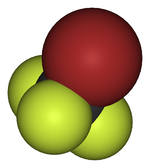| Bromotrifluorométhane |
 |
| représentations du Bromotrifluorométhane |
| Général |
| Nom IUPAC |
bromotrifluorométhane |
| Synonymes |
fréon 13B1,
halocarbone R13 B1,
halon 1301,
R13B1 |
| No CAS |
75-63-8 |
| SMILES |
|
| InChI |
InChI : Vue 3D
InChI= 1/ CBrF3/ c2- 1( 3, 4) 5
|
| Apparence |
gaz comprimé, liquéfié, incolore[1]. |
| Propriétés chimiques |
| Formule brute |
CBrF3 [Isomères]
|
| Masse molaire[3] |
148,91 ± 0,002 g·mol-1
C 8,07 %, Br 53,66 %, F 38,27 %,
|
| Moment dipolaire |
0,65 ± 0,05 D [2] |
| Propriétés physiques |
| T° fusion |
-168 °C[1] |
| T° ébullition |
-58 °C[1] |
| Point critique |
39,7 bar, 67,05 °C [4] |
| Thermochimie |
| Cp |
équation[5] : 
Capacité thermique du gaz en J·mol-1·K-1 et température en kelvins, de 100 à 1 500 K.
Valeurs calculées :
69,151 J·mol-1·K-1 à 25 °C.
T
(K) |
T
(°C) |
Cp
 |
Cp
 |
| 100 |
-173,15 |
39 219 |
263 |
| 193 |
-80,15 |
55 264 |
371 |
| 240 |
-33,15 |
61 978 |
416 |
| 286 |
12,85 |
67 749 |
455 |
| 333 |
59,85 |
72 905 |
490 |
| 380 |
106,85 |
77 387 |
520 |
| 426 |
152,85 |
81 187 |
545 |
| 473 |
199,85 |
84 537 |
568 |
| 520 |
246,85 |
87 409 |
587 |
| 566 |
292,85 |
89 815 |
603 |
| 613 |
339,85 |
91 910 |
617 |
| 660 |
386,85 |
93 690 |
629 |
| 706 |
432,85 |
95 171 |
639 |
| 753 |
479,85 |
96 458 |
648 |
| 800 |
526,85 |
97 554 |
655 |
|
T
(K) |
T
(°C) |
Cp
 |
Cp
 |
| 846 |
572,85 |
98 476 |
661 |
| 893 |
619,85 |
99 291 |
667 |
| 940 |
666,85 |
100 005 |
672 |
| 986 |
712,85 |
100 626 |
676 |
| 1 033 |
759,85 |
101 200 |
680 |
| 1 080 |
806,85 |
101 725 |
683 |
| 1 126 |
852,85 |
102 201 |
686 |
| 1 173 |
899,85 |
102 655 |
689 |
| 1 220 |
946,85 |
103 077 |
692 |
| 1 266 |
992,85 |
103 457 |
695 |
| 1 313 |
1 039,85 |
103 805 |
697 |
| 1 360 |
1 086,85 |
104 103 |
699 |
| 1 406 |
1 132,85 |
104 330 |
701 |
| 1 453 |
1 179,85 |
104 480 |
702 |
| 1 500 |
1 226,85 |
104 524 |
702 |
|
|
|
Unités du SI & CNTP, sauf indication contraire.
|
Le gaz Bromotrifluorométhane, appelé également trifluorobromométhane, Halon 1301, R13B1, Halon 13B1 est un halon qui a pour formule CBrF3. C'est un gaz inerte, non-inflammable.
Usage
Introduit dans les années 1960 en tant qu'agent d'extinction d'incendies, on l'utilisait sur du matériel de valeur (avions, ordinateurs, centres de télécommunication, ...), dans des systèmes à noyage total. On évite généralement de longues expositions au Halon 1301, en se limitant à des concentrations n'excédant pas 7% et sur une durée inférieure à 15 minutes. À des concentrations plus élevées, le système central nerveux commence à être affecté.
Avant qu'on l'identifie en tant que gaz à effet de serre, beaucoup d'entreprises de refroidissement l'utilisaient en tant que gaz réfrigérant.
Notes et références
- ↑ a, b et c BROMOTRIFLUOROMETHANE, fiche de sécurité du Programme International sur la Sécurité des Substances Chimiques, consultée le 9 mai 2009
- ↑ (en) David R. Lide, Handbook of chemistry and physics, CRC, 16 juin 2008, 89e éd., 2736 p. (ISBN 142006679X et 978-1420066791), p. 9-50
- ↑ Masse molaire calculée d’après Atomic weights of the elements 2007 sur www.chem.qmul.ac.uk.
- ↑ Properties of Various Gases sur flexwareinc.com. Consulté le 12 avril 2010
- ↑ (en) Carl L. Yaws, Handbook of Thermodynamic Diagrams, vol. 1, 2 et 3, Huston, Texas, Gulf Pub. Co., 1996 (ISBN 0-88415-857-8, ISBN 0-88415-858-6, ISBN 0-88415-859-4)
Wikimedia Foundation.
2010.
Contenu soumis à la licence CC-BY-SA. Source : Article Bromotrifluorométhane de Wikipédia en français (auteurs)
Regardez d'autres dictionnaires:
Bromotrifluoromethane — IUPAC name … Wikipedia bromotrifluoromethane — noun The halogenated hydrocarbon CBrF once used in fire extinguishers … Wiktionary bromotrifluoromethane — /ˌbroʊmoʊˌtraɪˌflʊəroʊˈmiθeɪn/ (say .brohmoh.truy.floouhroh meethayn) noun → halon … 75-63-8 — Bromotrifluorométhane Bromotrifluorométhane représentations du Bromotrifluorométhane Général Nom IUPAC … Wikipédia en Français CBrF3 — Bromotrifluorométhane Bromotrifluorométhane représentations du Bromotrifluorométhane Général Nom IUPAC … Wikipédia en Français Halon — can refer to:* Haloalkane, or halogenoalkane, a group of chemical compounds consisting of alkanes with linked halogens * Various gaseous fire suppression agents: ** Halon 1211 (bromochlorodifluoromethane, CF2ClBr) ** Halon 1301… … Wikipedia Bromochlorodifluoromethane — IUPAC name … Wikipedia Halomethane — compounds are derivatives of methane (CH4) with one or more of the hydrogen atoms replaced with halogen atoms (F, Cl, Br, or I). Halomethanes are both naturally occurring, especially in marine environments, and man made, most notably as… … Wikipedia BTM — can refer to: *Business Technology Management (BTM) *Business Transaction Management *Bangladesh Traverse Mercator *Behind the Music *Bell Telephone Manufacturing company in Belgium, part of Alcatel *Bromotrifluoromethane *Bronx Terminal Market… … Wikipedia IPCC list of greenhouse gases — This is a list of LLGHG (long lived greenhouse gases) greenhouse gases as used by the IPCC TAR. Contents 1 Gases relevant to radiative forcing only (per IPCC documentation) 2 Gases relevant to radiative forcing and ozone depletion (per IPCC… … Wikipedia
|




